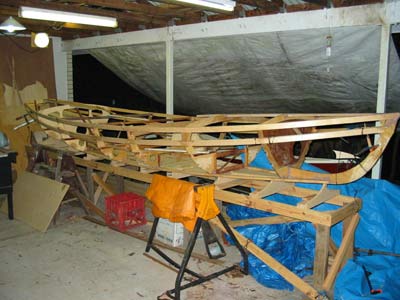Interview with John Welsford
by Sandra Leinweber
We met John
Welsford the first time in Port Townsend at the 2002
Wooden Boat Festival. We had been his US agent for the sale of
his plans for about a year at that point. Our visit to the area
overlapped by several days, but in a series of almost comic near
misses, we did not connect until the last evening of our stay.
I will never forget the moment when Chuck and John spotted one
another. Each had seen nothing more than a photo of the other.
It was late in the afternoon, and all of us were weary, but they
came together like magnets, and spent the next couple of hours
in intense conversation. All our business since that first meeting
has been conducted through email and the occasional phone call.
This time, we had the time to just sit and talk about everything,
and this interview is just a small slice of what we learned from
and about John.
 Sandra:
I would like to start with your background, establish the fact
that even though you are from New Zealand, you are just a regular
guy who happens to be a boat designer. (tongue firmly in cheek) Sandra:
I would like to start with your background, establish the fact
that even though you are from New Zealand, you are just a regular
guy who happens to be a boat designer. (tongue firmly in cheek)
John:
That Kiwis are human, actually.
Sandra: Yes.
John:
I’m a New Zealander, 6th or 7th generation. Which is a long
time considering that New Zealand is a very young country. The
bulk of my ancestry is Scots Irish even though the name is very
English. Amongst the notable ancestors is a guy who got shot for
stealing horses in Australia and then on my mother’s side
is the William Denny family - people who established and ran the
Denny shipyards in Scotland—building full sized ships. They
had the first workable professional testing tank in the world.
It was set up for developing the hulls for the ferries that ran
across to the Isle of Man and to Ireland and across the English
Channel. They made significant gains in hull shape and efficiency.
They also used the tank to develop the Denny Stabilizing gear
(active fins), that is now the norm on passenger ships all over
the world.
Sandra: It sounds
as though boatbuilding is in your blood.
John:
Yep. There has been a boatbuilder in every generation, back as
far as my Dad could go, which was nearly 200 years, or about 10
generations. I am the current one. Although now my building is
less and the drawing of the plans is more.
Sandra: How did
you start, and what has influenced you over the years?
John:
I started off building tin—that’s corrugated roofing
iron—boats at nine years old, scraping melted tar off the
roads to caulk them with on a hot day, folding up the sheet metal
and nailing it to bits of firewood at the end to form the stems.
I soon learned the the ones with lots of rocker curved fore and
aft were generally more stable, but they didn’t go straight.
And the ones that were straight from one end to the other fell
over sideways and were hard to turn, but they would go straight.
So I had the beginnings of lessons in those principles, and they
are still there- they still apply.
Sandra: Was your
father a boatbuilder?
John:
No, my father was a farmer. My grandfather managed the books for
a one man boatbuilding company where he lived, and at 9 or 10
years old, I spent all of my holidays at my grandparents’
place. My parents were very pleased to see the back of me for
a month or so at a time. It was my job to sweep the floor, tail
out the machinery when there was big lumber going through, and
stay out of the way. That was my first contact with boatbuilding.
It was traditional boat building, carvel planked, steamed frame
building, and again, there are lots of lessons from there.
Sandra: Did you
spend time in boats then as well?
John:
Yep, boats of my own, and my grandfather’s little clinker
dinghy that he used to take me fishing in. I didn’t have
a sailboat until much much later. In fact, I was well into my
thirties before I owned a sailboat that didn’t have a cabin
on it. My first few had cabins. Open boats came to me much later
in my career than most designers.
Sandra: Do you
prefer open boats?
John:
I much prefer open boats. The cruising sailing dinghy is my perfect
boat. In a big boat, to have a real adventure, involves something
like sailing round the Horn. You can have an adventure that’s
just as vivid and real and memorable as sailing round the Horn
in a cruising, sailing dinghy - over one weekend, 20 miles from
home.
Sandra: Is that
just because of the size of the boat and the relative feelings
of stability?
 John:
Yes. A small boat connects you with the sea very strongly. You
are sailing around the edges rather than out in the deep stuff.
Blue water sailing in my mind is boring—just something you
have to do to get from one interesting cruising ground to another.
In a sailing dinghy the cruising grounds are more intimate, much
more real. Another really interesting thing in a cruising sailing
dinghy is that lots of people, come up to talk. Sailing in a big
boat, nobody wants to know. There are issues also around the boat.
The bigger the boat the fewer hours you spend enjoying it in relation
to the hours spent maintaining it. And of course the issue of
the amount of money that’s involved. These little boats
that I like to design live in the garage, you maintain them over
a couple of days, you can tow them at highway speeds to your cruising
grounds, they’re not intimidating, just a lot more fun.
Of course it is not a good idea to make your first cruise in a
small boat a 200 mile trip. Better to get used to the boat in
a calm bay. Learn how it handles and take it from there. John:
Yes. A small boat connects you with the sea very strongly. You
are sailing around the edges rather than out in the deep stuff.
Blue water sailing in my mind is boring—just something you
have to do to get from one interesting cruising ground to another.
In a sailing dinghy the cruising grounds are more intimate, much
more real. Another really interesting thing in a cruising sailing
dinghy is that lots of people, come up to talk. Sailing in a big
boat, nobody wants to know. There are issues also around the boat.
The bigger the boat the fewer hours you spend enjoying it in relation
to the hours spent maintaining it. And of course the issue of
the amount of money that’s involved. These little boats
that I like to design live in the garage, you maintain them over
a couple of days, you can tow them at highway speeds to your cruising
grounds, they’re not intimidating, just a lot more fun.
Of course it is not a good idea to make your first cruise in a
small boat a 200 mile trip. Better to get used to the boat in
a calm bay. Learn how it handles and take it from there.
Sandra: You often
design boats for individuals. How many of your commissions have
been added to your stock designs?
John:
Quite a lot. These days my practice has progressed to a point
– I won’t take on a commission unless I can add it
to my plans list. Even the more extreme ones will fit comfortably
into my list. That means that I can charge the original customer
a little less, and I have the projected income off in the future
from selling the plans several times.
Sandra: Does the
orginal design go through any changes over time?
John:
I try to keep it exactly the same. My Navigator
is a good example. It was designed for a specific job that did
not go ahead. Then a customer came in looking for a boat, we leafed
through my design proposals, he picked that one, and we drew a
new rig for it, opened the interior a bit, and that has become
Navigator. A little yawl rigged sailing dinghy with over 500 sets
of plans sold—it has become quite a phenomenon.

Dave Perillo in his Navigator, "Jaunty"
Sandra: Do you
have many designs on paper that have never been built?
John:
Stillborn? Yes. There are probably 40 or 50 tucked away.
Sandra: What makes
a Welsford design a Welsford design?
John:
That’s difficult for me to be objective about. I like to
watch people’s reactions. I have a style that people like.
I have an approach that I have deliberately worked on that trys
to accentuate certain features of a boat’s styling. Just
slightly to make them almost a caricature. Something that says,
I’m going to be like a Cape Cod catboat when I grow up.
Or perhaps, my Daddy was a Falmouth cutter, and I’m just
as good. There are features of traditional boats which people
remember fondly, and that they identify with. I try to fit those
into the styling of a boat, which may be in fact quite different,
but it connects. The boat is my translation of a person’s
dream image. If I can connect with the customer well enough to
identify that dream vision and translate it into a 3-dimensional
form, then it satisfies both the dream and the practical aspects
of the design, which is how it sails, how it builds, how it feels
when you are in it.
Sandra: You take
their ideas, filter them through your knowledge of what makes
a boat work, and design what is hopefully the ideal boat.
John:
Yes. Although there are times when it is quite difficult. If you
have somebody whose dream is a deep water, deep keeled, cutter
rigged, long distance ocean girdling boat and they sail in an
area where the water is knee deep for 200 miles, there’s
a bit of a conflict. That’s an extreme case, but it does
happen. You have to find something that satisfies both their vision
and the practical aspects of their chosen sailing grounds, or
it won’t work.
Sandra: I would
assume that the water in your part of the world is different in
some respects from the water in the States—not that we have
a typical sort of water. How do you go about advising someone
about which of your plans might work for them here?
 John:
I need to be familiar with the environment in which my customer
is going to use the boat. For example, a customer who is going
to buy a boat for Maine in the summertime will be quite different
from a customer who likes to sail fairly late in the season in
Seattle. John:
I need to be familiar with the environment in which my customer
is going to use the boat. For example, a customer who is going
to buy a boat for Maine in the summertime will be quite different
from a customer who likes to sail fairly late in the season in
Seattle.
Sandra: Why buy
your designs over an American designer?
John:
Well, the blunt one is that I need to make a living. I spend a
lot of time in my workshop. I might build only part of a design
and then destruct test it. I work very hard to make the boats
accessible to people with limited tools, limited skills, and limited
financial resources. The boats look complex, they look like a
million dollars, but they are achievable to people who have a
lot less than that. The boats work well, they are well tested.
Our sailing environment in New Zealand is robust, to say the least.
It blows like stink a lot of the time.
I
‘ve built 22 boats of my own design. I’ve been designing
for around 25 years, making me one of the more experienced small
boat designers, and I have specialized in small boats.
Sandra: Tell us
about your book, New
Zealand Backyard Boatbuilding. Is it a good introduction
for the beginning boatbuilder?
John:
Yes. The book could have been four times as fat, but it never
would have been published. It’s designed to introduce people
to the basic skills, to the concepts, to the ideas involved, and
from there, it’s not a long step to completing a boat. It
really is a primer. There are building tips in there, and how
to do it. There are cruising stories in there; that’s why
to do it. There’s a list of boats in there, and that’s
what to do.
Sandra: Do you
give any recommendations on where to start with building a boat?
John:
Yes. The book has some good ideas, and anyone can contact me and
say this is what I want to achieve., and we can explore it together.
They might decide to start small, or perhaps just go ahead with
the boat they really want. By the time you finish your first boat,
your skills will have improved to the point where the finish will
be acceptable.
Sandra: Do you
find that most people don’t want to start small, but have
a bigger boat in mind right from the beginning?
John:
In most cases I say, no, don’t build a little one for practice.
Build the boat you want. A big boat is actually not any more complex
or difficult than a small boat. There’s more of it, but
each individual task in the building is no more complex.
Sandra: You have
also said that a builder needs nothing more than a small kit of
tools.
 John:
That’s right. The tools are part of the resources that a
builder brings to the boat. The resources are their attitude,
the most important one of all. Their tools, the space in which
they build, their financial resources, and their time. Each one
of those needs to be considered. The actual tools, for even the
biggest boat, can fit into one box that can be carried from the
car to the garage. Other tools will speed the job up. It is possible
to build any one of my boats totally with hand tools. John:
That’s right. The tools are part of the resources that a
builder brings to the boat. The resources are their attitude,
the most important one of all. Their tools, the space in which
they build, their financial resources, and their time. Each one
of those needs to be considered. The actual tools, for even the
biggest boat, can fit into one box that can be carried from the
car to the garage. Other tools will speed the job up. It is possible
to build any one of my boats totally with hand tools.
Sandra: Plug-in
tools, right?
John:
No. Hand tools, what we call arm-strong tools. But from there,
a power jig saw will help, a power sander will help. But all they
do, is speed things up. They won’t change the quality.
At
the end of the process, it’s like my workshop which has
driven my wife to distraction. Mine is a full professional, joinery
workshop, with a mass of fixed machinery, 18 hand held power tools,
and huge collection of hand tools. Even so, I find I use about
a dozen tools 99% of the time. The others are just there to speed
things up.
Sandra: Have you
designed any boats specifically for American customers?
John:
One of the more recent designs was for a customer who wanted to
rowing cruise long distances up the East Coast. And he wanted
an auxiliary sail, so primarily a rowing boat that would sail.
That’s where Walkabout
comes from. He can sleep on board, and it was designed to fit
his particular set of requirements. The boat will cope with wintertime
in Maine and heavy weather. It will row in the canals and bays
with no problem.
Sandra: An open
boat?
John:
An open boat, but not entirely open, it’s decked on both
ends and has side decks. There’s a tremendous volume of
buoyancy in it , with space for a fairly large gent to lay down
with a tent up and sleep and be comfortable. The first Walkabouts
are getting close to completion, oddly enough in Australia.
I
designed it for Steven Paskey , who lives very close to the Chesapeake,
and he wanted to cruise the Maine Island Trail, which involves
50 miles of salt water in a couple of places. The boat needed
to be extremely seaworthy, but also the water in Maine in the
winter and summer can be very calm, so it will move nicely with
almost no wind. It will cope with really heavy weather if it has
to. A rowing boat can’t move fast enough to make shelter
if you are rowing across 50 miles, so I expect him to watch the
weather forecast pretty closely. If he gets caught, it has a much
better chance of survival than most boats.

Wayne Jorgensen's Walkabout in frame
If
I am designing a boat, I will look at the indigenous boats in
an area with weather systems similar to the ones where my customer
lives. For instance, if I am looking to design a super seaworthy,
blue water small sailing boat, I’ll go and have a look at
the boats which oringinated south of England, on the other side
of the English channel, around the Breton coast. Those boats have
evolved in an area where they have 30% gale force winds. They
have strong fast currents, big waves, and conditions which most
Americans, with all respect, would consider to be extreme, and
would not go out in. A boat that has evolved in those conditions
will have seaworthiness and handling characteristics that are
consistent with the aims of my design.
If
I’m designing for Galveston Bay, or the Florida Keys, where
the winds are mild and gentle most of the time, and you don’t
go sailing when it’s not, I look for boats that have originated
in that sort of area.
Sandra: How available
are you and what can be learned from reading your book or the
catalog of your plans?
John:
I am available through email to just about any one who has bought
a set of plans or who is thinking about building one of my boats.
There is a Welsford builder’s discussion
group online that is quite active and in which I
participate. In the catalog, I write a story to go with the pictures
and description of each boat. The story is written to illustrate
the use for which the boat is intended. The story for my new design,
Swaggie, is a particularly good one. Now those stories are fiction,
but are intended to illustrate the best use for the boat. I spend
a good deal of time talking to customers. I get feedback, telling
me what their individual environments are like.
I
travel regularly, talk with other designers. I look at the boats
that are indigenous to an area, and I get clues from all of those
things.
Sandra: You are,
at least in our experience, extremely available.
John:
Yep. Don’t tell my wife.
We spent 3 days with
John, and the time flew. I honestly think he could discuss any
subject, his range of interest and experience is so wide. We learned
a great deal about New Zealand, its system of government, its
people, its geologic history. No citizen is more than 50 miles
from the sea at any time. The water is a constant presence, and
a huge percentage of the populace spend time in boats. John is
the epitome of WYSIWG—a charming, knowledgeable, intense
man who is a family man, master boat designer, and adventurer.
|

